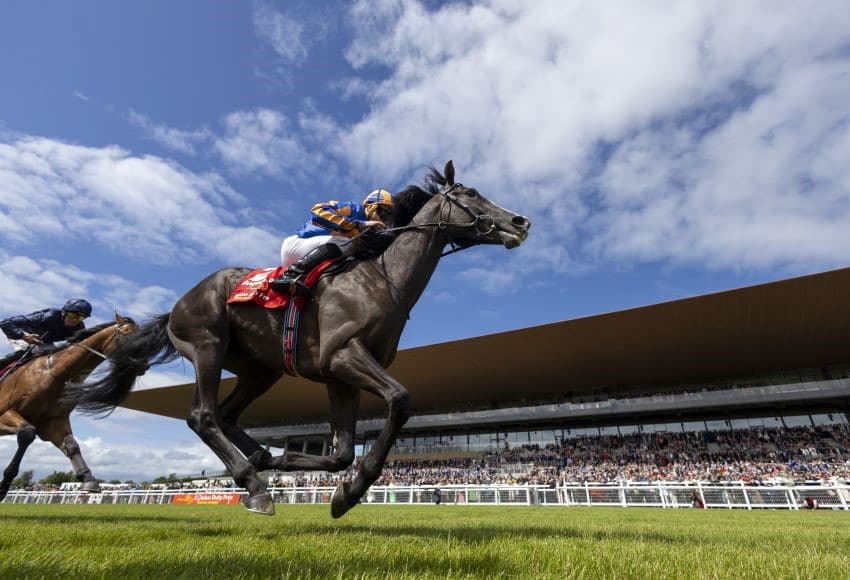How to Read Horse Racing Form – Pick a Winner
Sean Cornell, Editor
Last Updated: 13/11/2025
Matteo Farina, Senior Editor
Fact-checker
Knowing how to read horse racing form is the key to unlocking smarter bets and consistently picking winners. In this guide, you’ll find all the race information you need to make sense of race card data.
- Show full guideShow less
Horse Racing Form: The Basics
Understanding horse racing form can help you separate the wheat from the chaff. It’s essentially a key to unlocking a horse’s recent form and past performances, which is vital for smart betting.
Form is one of the most important aspects of learning how to bet on horses in the UK and Ireland.
What is Horse Racing Form?
Horse racing form is a covers the competitive history of a race horse. Think of it as its performance record, which illustrates how it’s fared in previous runs.
These are the key details you’ll find included.
Horse Name & Info
Start with the basics – the horse’s age, sex, and sometimes its pedigree. These details, which are often available on horse racing betting sites, hint at experience, maturity, and breeding suitability for certain distances or surfaces. You’ll often see these noted clearly on major race cards, whether it’s the Cheltenham Festival or Royal Ascot.
Race Dates & Courses
Look at when and where the horse has run. Course type, layout, and direction all matter – some horses simply perform better at certain tracks. For example, a horse that loves Cheltenham’s uphill finish may struggle on the flatter courses seen at Newbury or Ascot.
Distances & Results
Each race entry shows the distance and finishing position (e.g., 1st, 3rd). Horses that consistently place well over similar trips are usually reliable. Stayers who perform strongly over longer distances at events like the Grand National or Punchestown Festival can often be trusted to handle stamina tests elsewhere.
Class of Race
The class tells you the level of competition – from handicaps and maidens to Listed and Group races. Moving up or down in class can make a big difference in performance. A horse running in Group 1 company at Royal Ascot, for instance, is facing the very top level of opposition.
Jockey & Trainer Details
Always note who’s riding and training the horse. A top jockey-trainer partnership or strong course record can be a major pointer. At the Cheltenham Festival, repeat winning combinations like Willie Mullins and Paul Townend are often worth following.
Weight Carried
The assigned weight affects how a horse runs. Carrying more than usual can test stamina, especially in handicaps. Weight changes between races are key when studying horses heading from a tough handicap like the Grand National to easier company next time out.
Track Conditions
Check whether the ground was firm, good, soft, or heavy. Horses often have clear preferences – a mudlark on soft ground might struggle on firm turf. Festivals like Punchestown or Aintree often see softer spring ground, while Royal Ascot typically offers faster summer going.
Odds
The starting price (SP) reflects how the betting public rated the horse’s chances. Short betting odds suggest confidence; longer prices can highlight overlooked value. For big meetings like Cheltenham or Ascot, market moves are especially telling as punters pile in on fancied runners.
Extra Notes
Look for quirks – things like running style (front-runner, hold-up horse) or equipment changes (blinkers, tongue tie). These can hint at improvement or potential issues. Spotting a small gear change ahead of a major festival run, such as at Glorious Goodwood, can give you an early betting edge.
Understanding these details helps you judge a horse’s current form and its chances in upcoming races.
Where to Get Racing Form in the UK
Finding racing form in the UK is straightforward once you know where to look.
🖥️ Online Platforms: Sites such as Racing Post, Timeform, and At The Races offer in-depth stats, analysis, and tips.
📰 Newspapers: Papers like The Racing Post publish full race-day form and ratings.
📋 On-Course Guides: Racecourse programmes include all the essential race-day details.
🏇 Betting Sites & Apps: You can use horse racing betting apps for live data, past results, and a mobile-friendly form for betting on the go.
Types of Racing Form Formats
Racing form comes in different styles. Here’s a quick rundown of the essential elements in a form guide:
- Tables: A grid-style layout with key stats for multiple horses. Easy to skim.
- Summaries: Written descriptions of a horse’s recent races. Found in expert previews.
- Charts & Graphs: Some modern tools on UK betting sites show performance trends.
- Compact Cards: Abbreviations and icons for quick info. Great for advanced punters.
How to Read Horse Racing Form in the UK
Horse racing form can look confusing at first. But once you know what to focus on, it can help you spot a winner. Here’s how to break it down.
Key Horse Details: Age, Sex, and Type
- Name: Don’t back a horse just because you like its name. Look deeper by learning how to read horse racing form.
- Age: Younger horses aged two or three may lack experience but often have untapped potential. Older runners tend to be more consistent but may be past their best.
- Sex: Colts, fillies, geldings and mares perform differently, and weight allowances can vary in sex-restricted races.
- Breed: Most UK races feature Thoroughbreds, but understanding a horse’s breeding helps you gauge stamina, speed and surface preference.
Form and Recent Results
Factor What to Look For Why It Matters Previous Races Check how active the horse has been. Too few runs might indicate inexperience or recovery from injury. Placings Look for horses that regularly finish in the top three. Consistent placings suggest reliability and good form. Recency Focus on recent performances and trainer changes. A strong run last month is more meaningful than a win six months ago; recent form often signals readiness. Jockey and Trainer: Key Influences
🏇 Jockey: Look for riders with strong win records, especially those familiar with the horse.
👨🏻💼 Trainer: Top trainers usually prepare their horses for specific conditions and races.
2️⃣ Combination: A proven jockey-trainer partnership can be a strong sign of intent.Odds Movement and Betting
- Starting Price (SP): The final odds show how much confidence punters and bookmakers have in the horse.
- Fluctuations: Sharp odds movements can suggest inside information or changing market sentiment.
- Value: Short-priced favourites are not always worth it. Long shots with solid form can offer better returns.
Track, Distance and Weather
Factor What to Look For Why It Matters Surface Identify whether the horse prefers turf, all-weather, or dirt. The going (firm, good, soft, or heavy) can heavily influence performance. Distance Check how the horse has fared over similar race lengths. Some excel in sprints, while others perform better over longer, staying trips. Weather Consider how rain, wind, or dry conditions may affect the track. Changing weather can alter the going, so favour horses proven in similar conditions. How to Analyse Horse Racing Form
Reading past performance data is the key to making better betting decisions. Here’s how to break it down.
Finishing Positions
These alter depending on the number of horses running and whether it’s a handicap race. But for simplicity, here’s a breakdown based on three places.
🥇 Win (1st): A clear indicator of good form.
🥈 Runner-Up (2nd): Shows consistency, even if not dominant.
🥉 Place (3rd): Suggests reliability, though perhaps lacking the extra edge to win.Form Trends
Trends are crucial to predicting long term performance.
🚀 Consistency: Horses finishing near the front on a regular basis are more reliable. Erratic results can signal unpredictability or underlying issues.
📈 Improvement: Look for horses moving up the placings. They may be finding form or adapting to new conditions.
📉 Decline: Falling results could point to injury, poor fitness or unsuitable races.Class and Competition
Grades and classes matter very much when learning how to read horse racing form. Whether you’re using UK gambling sites and apps or those from elsewhere, we recommend focusing on these.
📜 Class Levels: UK races are graded by quality, from maidens and claimers to Group and Listed races.
⬆️ Rising in Class: A horse stepping up after a win is facing tougher opposition.
⤵️Dropping in Class: A drop down can give a previously outclassed horse a better chance.Margins and Times
The margins between winners and also rans can be super tight.
📊 Margins: A close second in a strong race can be more impressive than an easy win in weak company.
⏳Times: Fast times or improving speed figures suggest good form, but always compare with the going. A slower time on soft ground can still be strong.
Understanding Race Grades and Conditions
To make better betting choices, you need to understand how race classes and track conditions affect performance. These factors often decide whether a horse wins or fades into obscurity.
Race Grades Explained
UK horse races are divided into classes that reflect the quality of the field. You can get a better understanding of the process by learning how to read horse racing form.
Race Type Description Key Insight Maiden Races For horses that have never won a race. Introduces young or inexperienced horses; a win can reveal early potential. Novice Races For horses that have won no more than once (flat) or twice (jumps). Helps lightly raced horses progress in class; often a step up from maidens. Handicap Races Horses carry weights based on official ratings to level the field. Common across flat and jumps racing; tests form and stamina, providing value betting opportunities. Conditions Races Horses carry set weights based on age, sex, or previous wins. Higher-quality races than handicaps; often a stepping stone to top-class contests. Classified/Listed Stakes Restricted to horses of certain ratings or previous performance. Ensures competitive racing among similar horses; good guide to form. Group/Pattern Races The elite flat races in the UK and Ireland, graded 1–3. Group 1 races feature the best horses, trainers, and prize money; Group 2 and 3 are slightly lower levels but still high quality. National Hunt Bumpers Flat races for jump horses, usually young or inexperienced. Prepares horses for hurdles or chases; form here indicates potential over jumps. Novice Hurdles/Chases For horses that haven’t won over hurdles/chases before the season. Highlights improving talent; stepping stone to open Grade races. Graded/Listed Jumps Races Top-class hurdles or chases, graded 1–3 or listed. Elite National Hunt contests, often targeting festivals like The Cheltenham Festival, are the pinnacle of the sport. Knowing where a horse has been competing shows whether it’s stepping up, dropping down or running at its usual level.
How UK Course Conditions Affect Racing
The going describes the surface condition and has a big impact on performance. Whether you’re indulging in odds at live betting sites or ante-post prices on apps, it will affect a race.
- Firm: Hard and fast, suiting quick-ground horses but tough on legs.
- Good: The most common and generally fair for most runners.
- Soft: Slower turf that suits strong stayers.
- Heavy: Deep and energy-sapping, demanding real stamina.
All-weather tracks provide more consistency but can favour certain running styles.
Matching Horses to Race Conditions
To pick a winner, match a horse’s strengths to the race setup.
✅ Surface: Check if the horse has won on similar ground before.
✅ Distance: Sprinters rarely stay longer trips and vice versa.
✅ Going Preference: Identify whether the horse performs best on firm, good, soft or heavy going.
✅ Weight: In handicaps, see how the horse has managed similar loads in previous runs.By assessing these details, you’ll give yourself the best chance of backing a horse suited to the day’s conditions.
Understanding Weight in Horse Racing
Weight is a crucial factor in horse racing and can significantly influence a horse’s performance. The total weight a horse carries includes the jockey, the saddle, and any extra assigned weights.
Understanding how weight affects speed and stamina can help you assess a horse’s chances in a race. Analysing weight changes and trends provides valuable insight when predicting outcomes, which is why learning how to read horse racing form is crucial to your efforts.
How Weight Impacts Performance
The weight a horse carries affects both speed and endurance. Heavier loads often slow horses down, particularly over longer distances or on soft ground.
👉 Suitability: Lighter horses usually finish strongly, while those carrying extra weight may tire quickly, especially if not suited to it.
Allowances and Penalties in UK Racing
🎯 Allowances: Reductions, such as 5 lbs off, are given to younger or less experienced horses, or to mares racing against colts, to level the playing field.
⛔ Penalties: Extra weight is applied to horses that have recently won or competed at a higher class, ensuring fairness and competitive balance.
Using Weight to Assess Races
UK and Irish punters closely observe weight changes. A horse that performed well under a heavy load may thrive with less weight next time. Conversely, one carrying a penalty after a win could struggle against lighter rivals.
📢 Always Check: Reviewing past races and the weights carried can highlight which horse is best positioned to finish strongly.
Understanding Speed Ratings and Racing Metrics
Speed ratings and other performance metrics are key tools for assessing a horse’s ability. They simplify complex data into easy-to-read numbers, making it easier to compare runners across different races and conditions.
🤔 Factor Everything In: By factoring in speed ratings, track conditions, distances, and class levels, punters can make better-informed bets.
What Are Speed Ratings?
Speed ratings reflect how quickly a horse completes a race, adjusted for factors such as track surface, distance, and pace. For example, Timeform Ratings, widely used in the UK and Ireland, provide a standard measure of a horse’s performance.
🧐 On the Up: Higher ratings indicate a stronger run, offering insight into a horse’s potential.
Comparing Ratings Effectively
Speed ratings are most useful when comparing horses you’re going to watch through Racing TV or another source. A horse consistently earning ratings of 90 is likely more competitive than one in the 70s. However, context matters — lower ratings may result from tough race conditions or unfavourable tactics.
🌟 Rising Stars: Look for horses showing steady improvement or performing well under similar conditions.
Other Key Metrics: Pace and Sectionals
Pace shows how fast a race is run across different stages. Front-runners and closers have advantages depending on the race setup.
Sectional Times divide a race into segments, revealing hidden ability, such as a horse finishing mid-pack with a strong final burst.
🤝 Put it Together: Combining speed ratings with pace and sectional times gives a clearer picture of a horse’s style, stamina, and potential for success.
Spotting Value Bets and Avoiding Mistakes
Finding value bets involves identifying odds where bookmakers underestimate a horse’s true chance of winning. Key points to consider:
✅ Horses dropping in class or returning to a preferred surface or distance
✅ Runners with strong speed ratings or sectional times despite finishing poorly
✅ Horses suited to the conditions on the day, such as soft ground or smaller fields
Avoid weak favourites. Many bettors back favourites assuming they are safe, but a short-priced horse with poor recent form, weak course records, or inconsistent speed figures is risky. Base decisions on data rather than market hype.
Bankroll Management and Patience
Consistent profit on UK or non UK betting sites requires discipline as well as learning how to read horse racing form.
✔️ Flat staking: Bet a small, consistent percentage of your bankroll, typically 1–3 per cent
✔️ Do not chase losses: Stick to your analysis rather than placing bets to recover money
✔️ Be selective: Avoid races without clear value opportunities
Patience and careful bankroll management help you capitalise on value bets and manage losses.
Step-by-Step Guide to Picking a Winner
This guide will help you get the hang of what is needed to successfully pick winners.
How to Analyse Horse Racing Form
Follow these steps to systematically review races and identify potential winners.
Study the Basics
Review the race type, distance, going, and field size. These factors help eliminate unsuitable contenders.Assess Recent Form
Examine each horse’s last five or six races for trends such as consistent placements, strong finishes, or improvement. This indicates current fitness and suitability.Evaluate the Competition
Consider the quality of recent opponents. A close second in a competitive race may carry more weight than a win in a weak field.Analyse Course and Distance Suitability
Horses often perform better over certain tracks or distances. This history can give a predictive edge.Understand the Jockey and Trainer Impact
Successful jockey-trainer combinations, particularly in major races like the Cheltenham Festival or the Grand National, can make a notable difference.Incorporate Speed Ratings and Sectional Times
Horses with strong speed figures or favourable sectionals under similar conditions often have an advantage.Check the Odds for Value
Compare your shortlisted horses to the market odds, seeking selections offering good value rather than backing favourites blindly.
Examples of Racing Form Analysis in Action
Applying these steps consistently builds a structured, evidence-based approach to form analysis. When you learn how to read horse racing form and combine that with patience and bankroll discipline, it can improve long-term betting success.
- Scenario 1: A horse finishing close in Grade 1 races drops to a Grade 2 event. Combined with favourable course stats, this could signal a strong betting opportunity.
- Scenario 2: A runner with fast sectionals on soft ground faces similar conditions today, making it a strong contender.
Conclusion
Reading horse racing form effectively is a vital skill for any serious UK punter. Whether analysing races online or at the racecourse, understanding key elements such as past performance, going, course and distance records, jockey and trainer statistics, and recent sectional times is essential for making informed betting decisions.
It is normal to feel overwhelmed at first. Like any skill, form analysis improves with practice. Regularly reviewing races, noting insights, and refining your approach will help you identify value and make smarter bets. Always gamble responsibly, set a budget, and never stake more than you can afford to lose.
FAQs
How can I use form figures to judge a horse’s performance?Form figures show a horse’s finishing positions in previous races. Numbers like 1-2-3 indicate consistent top finishes, while letters such as F (fell), U (unseated), or R (refused) highlight incidents. As such, learning how to read horse racing form helps identify improving or declining horses.What should I look for in jump racing?Check how the horse handled fences in past events. F or UR entries signal risk. Also, consider performance in similar conditions, distances, and previous season results. For inexperienced runners, point-to-point form can be useful.What do letters mean in the Grand National?Letters like F, R, and U show if a horse failed to complete a race. In long, challenging contests such as the Grand National, this indicates whether a horse can cope with large fields and extended distances. Review past season results for context.How do I find the best horse using the racecard?Start with the horse’s name and form figures. Then check weight, distance, ground conditions, and class level. Previous-season form and expert previews provide additional insight.Does form differ between jump and flat racing?Yes. Jump racing form includes incidents like falls or refusals, while flat racing form is usually simpler. Also, consider when the form was recorded, as UK racing seasons differ between summer and winter.Why is past record important?A horse’s history shows patterns in performance, consistency, and fitness. Missed seasons, past incidents, or distance preferences are key indicators of current form and potential.Resources:
Sean Cornell, Editor
Sean is an editor and contributor with a huge passion for esports and all things sport. He’s written for some of the internet’s biggest platforms and brings sharp insight and knowledge to Esports News UK. When Sean is not covering the latest stories or sports betting guides, you’ll find him following rugby or boxing – his two favourite sports.
This article has been Fact-checked by Matteo Farina
We prioritize accuracy, objectivity, and depth in every piece of content we produce. Our rigorous editorial standards ensure that all information is carefully sourced and fact-checked. Each article is meticulously reviewed by experienced editors and leading technology professionals to maintain the highest level of credibility and relevance. This commitment guarantees our readers content they can trust and rely on.
From breaking news and in-depth match analysis to exclusive interviews and behind-the-scenes content, we bring you the stories that shape the esports scene.
40k+Monthly Visitors
100%User Satisfaction
10+Years experience
Popular Pages
Explore Categories











